
 |
Stanton Arthur Coblentz is a very problematical figure in science fiction in the first half of the 20th Century. Born in 1896, he had a long life, dying in 1982. After getting a Master's in English, he began to publish poetry, and continued to write verse and contribute literary and social criticism until advanced old age. |
However, he is mainly remembered for his science fiction. He placed a novel, “The Sunken World,” in AMAZING STORIES QUARTERLY (July 1928 issue), and continued to be a regular contributor to the early science fiction pulps, with 4 short stories in 1929, and typically placed one to five shorts per year from 1929 through the 1950s, while also usually publishing around one novel per year. Indeed, he comes close to matching Murray Leinster, Jack Williamson and Edmond Hamilton for length of active career as a science fiction writer. The puzzle, with Coblentz, is how he had a career at all... since he was an absolutely terrible writer of fiction. His style was generally clumsy, stiff, stumbling, archaic, excessively expository, and his characters were the thinnest cardboard. For most of his career, most of his work was published in the Gernsback pulps... infamous for their low word-rates and often (when they could get away with it) no payment at all. One hopes Coblentz was not depending on his science fiction for an income! As for his verse, what little of it I have seen is trite, very old-fashioned by the standards of the 1920s, and generally quite lacking in any degree of literary merit. Coblentz remained a staunch critic of essentially all the early 20th Century trends in poetry, and was a veritable poetic dinosaur as viewed by mainstream literary critics of his day.
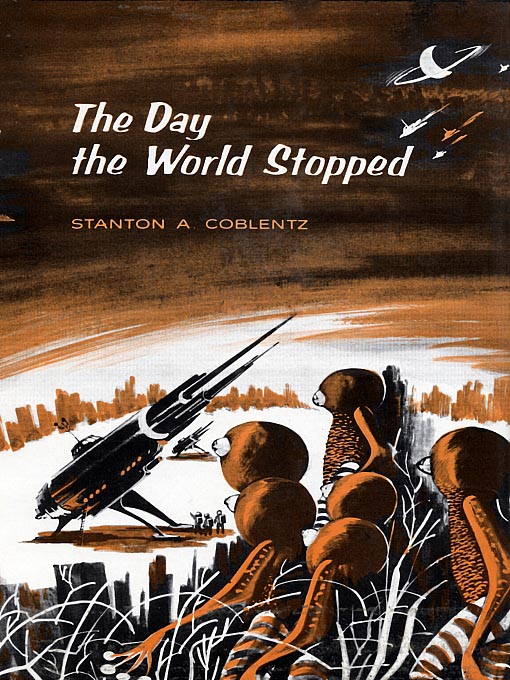 |
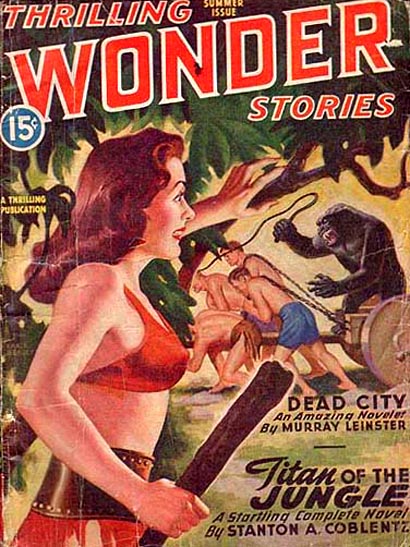 |
I first became aware of Coblentz
in the late 1950s and early 1960s, when the local library
started buying inexpensive science fiction hardbacks issued by Avalon Books.
The ultra-low-budget concept on which Avalon's
list was based was the concept of going back to the
general fiction and science fiction pulps of 1900 - 40 and
digging out science fiction novels by various, often-forgotten
writers, to be issued in hardback for the very first time. The
editor seems to have been the legendary Robert A. W. “Doc”
Lowndes (1916-1998). Coblentz often dominated the list of about
160 eventually-published titles. Opening a few volumes at random
and reading a few paragraphs, I found most of these authors to
be of little or no interest... especially not Coblentz! You can
check out his novel The Cosmic Deflector (1943) on-line
here. Also Flight Through
Tomorrow. As far as the Avalon editions are
concerned, beware that they are often very
drastically edited and abridged, without any publisher's
indication of such abridgement, as is easily seen when they are
compared to the original pulp-magazine versions. The truncations
do great harm to Coblentz, in particular, since they often
remove his long, carefully prepared-for and continually
expanding descriptions of alien scenes... descriptions that are
probably his only strength as a writer.
Well, so why am I writing about him? Sometime in the early 1980s I encountered a paperback edition of Hidden World [aka In Caverns Below, from 1935]. Reading it, I found that despite those characteristic defects I had earlier noted, the novel had a sometimes-interesting sociopolitical satirical subtext. The 1980s were a Golden Age of used paperback bookstores and I quickly obtained several more softbound novels by Coblentz. All had that element of social satire, sometimes feeble, sometimes more effective. I started looking for some of his works that had only been published by Avalon, but the prices of all such books were rapidly escalating and I simply had to give up on a number of titles. Coblentz had one more thing going for him besides the satire— his alien creations often had that so-called “sense of wonder” that was fairly common in science fiction tales of 1926 - 1940, only to disappear completely from the field thereafter. Sample Coblentz' Under the Triple Suns (1955, often mentioned in this context) to see what I mean. Another aspect of Coblentz' fiction that sets him a bit apart from his contemporaries is his creation and depiction of strong and resourceful female characters.
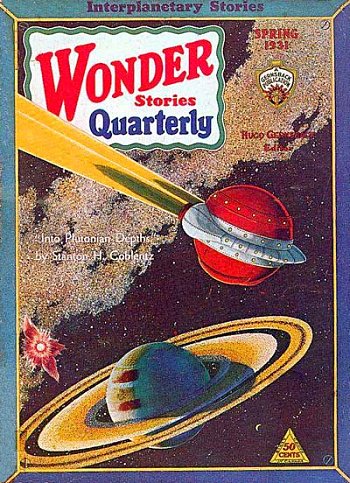 |
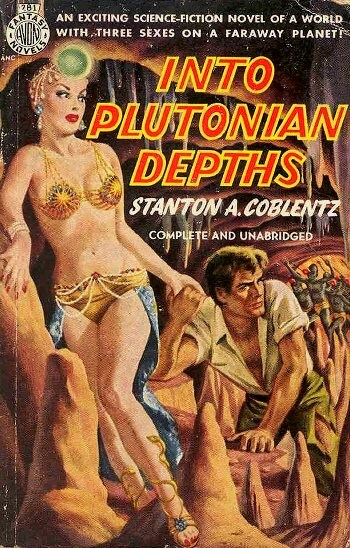 |
A number of Coblentz novels came into print as paperbacks during the “science-fiction-paperback explosion” of 1950 - 60. There's quite a story behind one of them.... the 1950 Avon edition of his novel Into Plutonian Depths, which had originally appeared in the pulps back in 1931. To shed light on what happened, I have to explain that in those days one common bit of slang referring to homosexuals was “the third sex.” The front cover blurb on this paperback proclaimed it to be “An exciting science fiction novel of a world with three sexes on a faraway planet!” The cover painting showed a scantily-clothed figure of somewhat ambiguous sexuality... not deliberately, just through the ineptitude of the artist. And the reference to “Plutonian Depths” might seem to suggest a main target of sexual interest among gays. The totally unexpected result was that the paperback became a modest best-seller, due to heavy sales among the nationwide gay community!
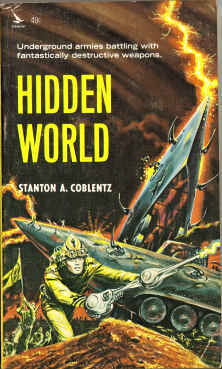 |
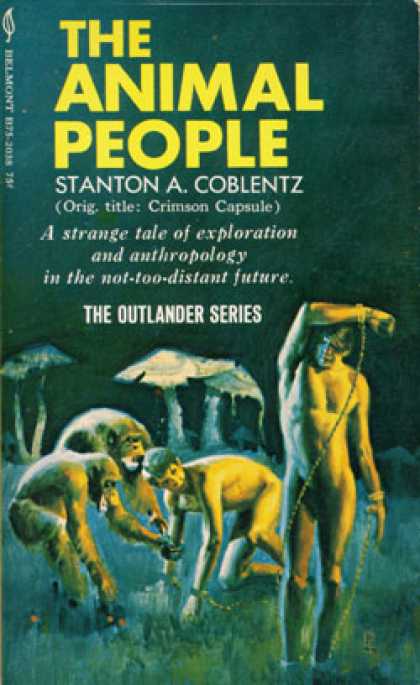 |
A Polish writer whose works appeared in English in the 1970s and who was often compared to Coblentz was Stanislaw Lem (1921 – 2006). About the only distinctive similarities I have noted between them, myself, are the tendency in both towards generally heavy-handed and ineffective social satire. Certainly, Lem's novel The Invincible (1964, 1973) is as completely awful as anything ever written by Coblentz. One explanation for Coblentz' failure to evolve or improve as a writer might be that he had drawers-full of unsold manuscripts, written years before, which he tried to place throughout the 1940s, 1950s and 1960s. For example, the one and only issue of a 1960s neo-pulp, Tales of Terror from the Beyond (Summer 1964), apparently has its entire contents written by Coblentz, except for a single tale by Stanley Ellin.
I'll comment here on one Coblentz short story I have recently read, namely “The Crystal Planetoids,” originally published in 1942. I think it demonstrates fairly typically his strengths and defects. Three scientists, Philip Dunbar (the villain), Ronald Gates (our hero) and Eleanor Firth, are hard at work when Gates announces the need to test his Infra-Red Eye, a set of goggles that can penetrate thick mists. By no coincidence, the entire surface of the earth is currently covered by “a dull, blank haze [that obscures] everything beyond a few hundred yards.” When Gates walks outside with his goggles on, to his horror he finds the sky covered densely by great semi-transparent web-like arcs, and what's worse, running along the strands of the sky-web are semi-transparent, multi-limbed monsters about three times the size of humans. The webs turn out to be strung between dozens of “crystal planetoids” which have recently come to orbit our planet. Gates is snatched up by a monster, and soon discovers that the earth is being invaded by creatures from Saturn, who aim to raise the temperature of the surface to a level that will exterminate all living things. Eleanor and Dunbar are soon captives also, and Dunbar as expected turns traitor, offering to help the invaders in any way if he and a few selected others (particularly Eleanor, who loves Gates) are allowed to survive. Meanwhile Gates makes a friend of a disgruntled member of the invading force, Yellow-Claws, and begins to see how the hot tempers and proneness to violence among the Saturnians can be used to derail their plans. And Eleanor has not been idle; she has developed a weapon which, when fired, dissolves the Saturnian webs. At first she hesitates to use it globally, since she knows that several hundred humans are held hostage somewhere in the webwork that surrounds the earth. Fighting off attempts by Dunbar to sabotage her efforts and have her ignored, she eventually destroys the Saturnian structures, just as Gates and his fellow human captives successfully escape to the surface. It's a crudely written story with absurdly stilted dialogue and largely nonexistent characterizations. Dunbar is wicked because he has black hair, beady eyes and a trim mustache. The chief Saturnian leader, Red-Hood, expresses displeasure by actually breathing out smoke and fire. The relationships between the various factions among the Saturnian invaders are probably intended to be a parody of the supposed internal frictions among the Fascist leaders of 1940 Europe. Yet the story certainly has its elements of “sense of wonder,” particularly when the three human characters are in the crystal “planetoid” space ships from Saturn, or out along the strands between them.
The entry on Coblentz from Science-Fiction: The Gernsback Years by E. F. and Richard Bleiler, is available on-line through Google Books, here. You can also find a review of Coblentz' autobiography, published a year after his death, here. The autobiography itself is online, courtesy of Google Books, here. Coblentz was the recipient of the 6th annual First Fandom Hall of Fame award in 1981. At least three long interviews with him have been published over the years in various fan magazines, but I have not been able to track any of them down.